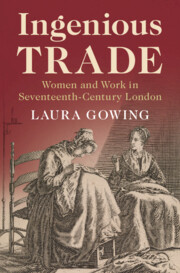Book contents
- Ingenious Trade
- Ingenious Trade
- Copyright page
- Contents
- Figures
- Tables
- Acknowledgements
- Introduction
- 1 Bred in the Exchange: Seamstresses and Shopkeepers
- 2 Girls as Apprentices
- 3 Managing the Trade: Women as Mistresses
- 4 What Girls Learned
- 5 Making Havoc: Discipline, Demeanour and Resistance
- 6 Freedoms and Customs
- Conclusion
- Appendix Who’s Who
- Bibliography
- Index
- References
Bibliography
Published online by Cambridge University Press: 29 November 2021
- Ingenious Trade
- Ingenious Trade
- Copyright page
- Contents
- Figures
- Tables
- Acknowledgements
- Introduction
- 1 Bred in the Exchange: Seamstresses and Shopkeepers
- 2 Girls as Apprentices
- 3 Managing the Trade: Women as Mistresses
- 4 What Girls Learned
- 5 Making Havoc: Discipline, Demeanour and Resistance
- 6 Freedoms and Customs
- Conclusion
- Appendix Who’s Who
- Bibliography
- Index
- References
Summary

- Type
- Chapter
- Information
- Ingenious TradeWomen and Work in Seventeenth-Century London, pp. 254 - 268Publisher: Cambridge University PressPrint publication year: 2021

